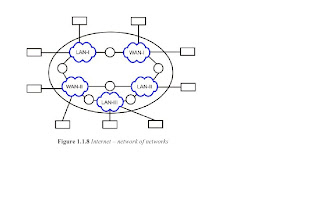Classification Based on Transmission Technology
Computer networks can be broadly categorized into two types based on transmission technologies:
• Broadcast networks
• Point-to-point networks
Broadcast Networks
Broadcast network have a single communication channel that is shared by all the machines on the network as shown in Figs. All the machines on the network receive short messages, called packets in certain contexts, sent by any machine. An address field within the packet specifies the intended recipient. Upon receiving a packet, machine checks the address field. If packet is intended for itself, it processes the packet; if packet is not intended for itself it is simply ignored.
This system generally also allows possibility of addressing the packet to all destinations (all nodes on the network). When such a packet is transmitted and received by all the machines on the network. This mode of operation is known as Broadcast Mode. Some Broadcast systems also supports transmission to a sub-set of machines, something knownas Multicasting.
Point-to-Point Networks
A network based on point-to-point communication is shown in Fig. The end devices that wish to communicate are called stations. The switching devices are called nodes. Some Nodes connect to other nodes and some to attached stations. It uses FDM or TDM for node-to-node communication. There may exist multiple paths between a source-destination pair for better network reliability. The switching nodes are not concerned with the contents of data. Their urpose is to provide a switching facility thatwill move data from node to node until they reach the destination.
Alternative criteria for classifying networks are their scale. They are divided into Local Area (LAN), Metropolitan Area Network (MAN) and Wide Area Networks (WAN).
Local Area Network (LAN)
LAN is usually privately owned and links the devices in a single office, building or campus of up to few kilometers in size. These are used to share resources (may be hardware or software resources) and to exchange information. LANs are distinguished from other kinds of networks by three categories: their size, transmission technology and topology. LANs are restricted in size, which means that their worst-case transmission time is bounded and known in advance. Hence this is more reliable as compared to MAN and WAN. Knowing this bound makes it possible to use certain kinds of design that would not otherwise be possible. It also simplifies network management.
LAN typically used transmission technology consisting of single cable to which all machines are connected. Traditional LANs run at speeds of 10 to 100 Mbps (but now much higher speeds can be achieved). The most common LAN topologies are bus, ring and star. A typical LAN is shown in Fig.

MAN is designed to extend over the entire city. It may be a single network as a cable TV network or it may be means of connecting a number of LANs into a larger network so that resources may be shared as shown in Fig. For example, a company can use a MAN to connect the LANs in all its offices in a city. MAN is wholly owned and operated by a private company or may be a service provided by a public company.

Wide Area Network (WAN)
WAN provides long-distance transmission of data, voice, image and information over large graphical areas that may comprise a country, continent or even the whole world. In contrast to LANs, WANs may utilize public, leased or private communication devices, usually in combinations, and can therefore span an unlimited number of miles as shown in Fig. WAN that is wholly owned and used by a single company is often referred to as enterprise network.
 The Internet
The InternetInternet is a collection of networks or network of networks. Various networks such as LAN and WAN connected through suitable hardware and software to work in a seamless manner. schematic diagram of the Internet is shown in Fig. It allows various applications such as e-mail, file transfer, remote log-in, World Wide Web, Multimedia, etc run across the internet. The basic difference between WAN and Internet is that WAN is owned by a single organization while internet is not so. But with the time the line between WAN and Internet is shrinking, and these terms are sometimes usedinterchangeably.


No comments:
Post a Comment